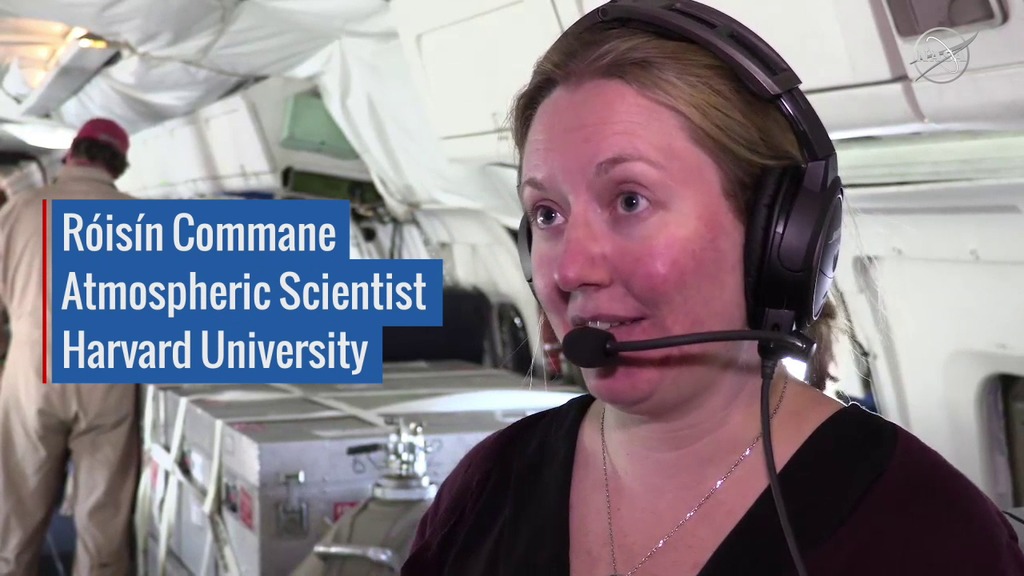ATom B-Roll
The Atmospheric Tomography (ATom) mission takes flight through Earth's atmosphere to understand how short-lived greenhouse gases like ozone and methane contribute to climate change. A suite of instruments aboard NASA's DC-8 flying laboratory will be taking measurements as the science team flies down the Pacific Ocean from Alaska to the southern tip of South America, then north up the Atlantic to Greenland to measure more than 200 gases and particles in the air and their interactions around the world.
B-roll available here is from the July 28, 2016, science flight from to the equator and back from Palmdale, California.
For more information:
NASA Airborne Study Surveys Greenhouse Gases in World Tour: https://www.nasa.gov/feature/goddard/2016/nasa-airborne-study-surveys-greenhouse-gases-in-world-tour
NASA Airborne mission Chases Air Pollution Through the Seasons: https://www.nasa.gov/feature/goddard/2017/nasa-airborne-mission-chases-air-pollution-through-the-seasons
ATom 1 Flight Path
ATom 2 Flight Path
ATom 3 Flight Path
ATom 4 Flight Plan
DC-8 Flight Pattern
The second worldsurvey of the atmosphere has begun! NASA’s Atmospheric Tomography or ATom mission completed its first science flight to the equator and back on January 26. Tour the DC8 flying laboratory loaded withairsampling instruments and out intrepid science team.
Credit: Chelsea Thompson
Video by Steve Parcel
Video by Steve Parcel
Video by Steve Parcel
Video by Steve Parcel
Video by Steve Parcel
Video by Steve Parcel
Video by Steve Parcel
DC-8 Takeoff
Video by Steve Parcel
Video by Steve Parcel

Sea ice in the Arctic as seen from ATom’s DC-8 in Janaury, 2017.
Credit: NASA / Róisín Commane

ATom is investigating the atmosphere above the remote oceans. Above the Atlantic ocean near Ascension Island, the research team saw haze from African fires during ATom’s February, 2017, flight.
Credit: NASA

The DC-8 is a research laboratory that has inlets in place of windows to draw air into ATom’s 20 instruments while it flies through the air.
Credit: NASA / Róisín Commane

The DC-8 at sunset on ATom’s second deployment in February, 2017.
Credit: NASA / National Center for Atmospheric Research / Becky Hornbrook

The DC-8 flies over Terceira Island in the Azores of the North Atlantic ocean, February, 2017.
Credit: NASA

Researcher photographing the sea ice as the DC-8 flies over the Arctic, January, 2017.
Credit: NASA / National Center for Atmospheric Research / Sam Hall
Credits
Please give credit for this item to:
NASA's Goddard Space Flight Center
-
Writer
- Ellen T. Gray (ADNET Systems, Inc.)
-
Videographer
- Steve Parcel (AFRC)
-
Scientists
- Steven Wofsy (Harvard University)
- Michael Prather (University of California, Irvine)
Release date
This page was originally published on Tuesday, January 31, 2017.
This page was last updated on Tuesday, November 14, 2023 at 12:20 AM EST.
![Christina Williamson of the National Oceanic and Atmospheric Administration (NOAA) studies aerosols, tiny particles in the air, either blown up from Earth's surface or forming in the atmosphere. These particles can affect the climate and human health, so understanding them better can help improve models and quality of life.Music: Pleasant Flight by David Backes [GEMA], Peter Moslener [GEMA]Complete transcript available.](/vis/a010000/a012900/a012966/Christina.png)
![Atmospheric scientist Róisín Commane talks about the secrets to a successful field campaign: plenty of snacks and getting enough sleep.Music: Digital Lives by Ben Wheeler [PRS], Theo Golding [PRS]](/vis/a010000/a012700/a012731/LARGE_MP4-ATom_BTS_1_large.00300_print.jpg)



![On its second worldwide tour, the Atmospheric Tomography (ATom) team starts by surveying the north’s polar regions during winter, which is marked by a build-up of pollution from the United States, Canada, northern China, and Russia. In the spring, sunlight spurs chemical reactions that remove those pollutants and greenhouse gases from the atmosphere.Music credit: Ice Lands by Rik Carter [PRS]Complete transcript available.](/vis/a010000/a012500/a012508/LARGE_MP4-12508_ATom1_Alaska_large.00721_print.jpg)



